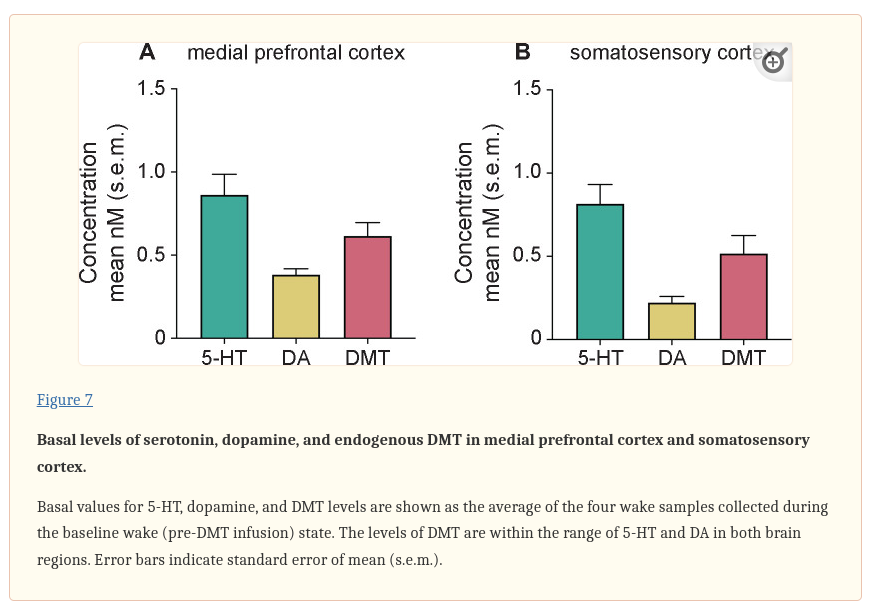A new 2024 study out of the University of Michigan by Dr. Nicolas Glynos utilized live micro-dialysis to measure the levels of endogenous DMT in the medial prefrontal cortex (mPFC) and the somatosensory cortex in live waking rats. This technique allows for the sampling of extracellular fluid in the brain while animals are freely moving. Dr. Glynos reports data showing that endogenous DMT was found at mean concentrations of 0.66 ± 0.08 nM in the mPFC and 0.54 ± 0.11 nM in the somatosensory cortex. By comparison, dopamine was found at mean concentrations of 0.39 ± 0.04 nM in the mPFC and 0.23 ± 0.04 nM in the somatosensory cortex. Endogenous DMT was also found at greater levels than that of glutamate which was found at mean concentrations of 0.41 ± 0.03 nM in the mPFC and 0.41 ± 0.02 nM in the somatosensory cortex (data found in Supplement 1).
This new data indicates endogenous DMT likely has a significant role in modulating mammalian neurology. Many decades of research have taken place regarding the effects of dopamine and glutamate regarding effects on pleasure, excitation, perception, and disease. The fact that DMT has been documented to exude anti-inflammatory effects in addition to it’s powerful visionary effects at high exogenous doses and mood modulating effects at low exogenous doses alludes to potentially multi-faceted roles for this endogenous psychedelic.
(Figure 7 from the Glynos study)

This new finding will undoubtedly spur greater interest regarding future research endeavors pertaining to DMT’s fundamental role within the mammalian body. Combining this data with that from the 2019 study produced by Dr. Jon Dean showing that endogenous DMT levels in the visual cortex were also comparable to dopamine and serotonin levels adds important data points for a more comprehensive perspective regarding mammalian neurochemistry.
Much speculation has taken place over the recent decades regarding endogenous DMT potentially being upregulated during near death experiences (NDE’s) and possibly during dreams. Other speculations have been postulated that DMT was largely produced by the pineal gland as well as the lungs. These 2 studies from Dr. Dean and Dr. Glynos have changed the discussion altogether being that it’s clear that DMT is produced in various parts of the mammalian brain at physiologically significant levels at baseline consciousness.
Future research endeavors measuring external and internal environmental factors that modulate DMT levels need to take place. Basic research such as unraveling the 24 hour circadian rhythm effect would provide a strong foundation for basic biological perspectives. Building upon circadian research with external influences such as sound, light flicker, extended darkness exposure, fasting, cold exposure, and exercise would add additional important data points to better understand the factors that upregulate or down regulate endogenous DMT in the mammalian brain.
DMT Quest is a non-profit 501(c)3 dedicated to raising awareness and funds for endogenous DMT Research. This specific field of psychedelic research has been underfunded for many decades now. It’s time to take our understanding of human physiology, abilities, and perception to the next level. E-mail me at jchavez@dmtquest.org with any comments or questions. You can also follow us at Facebook, Instagram, or Twitter.
